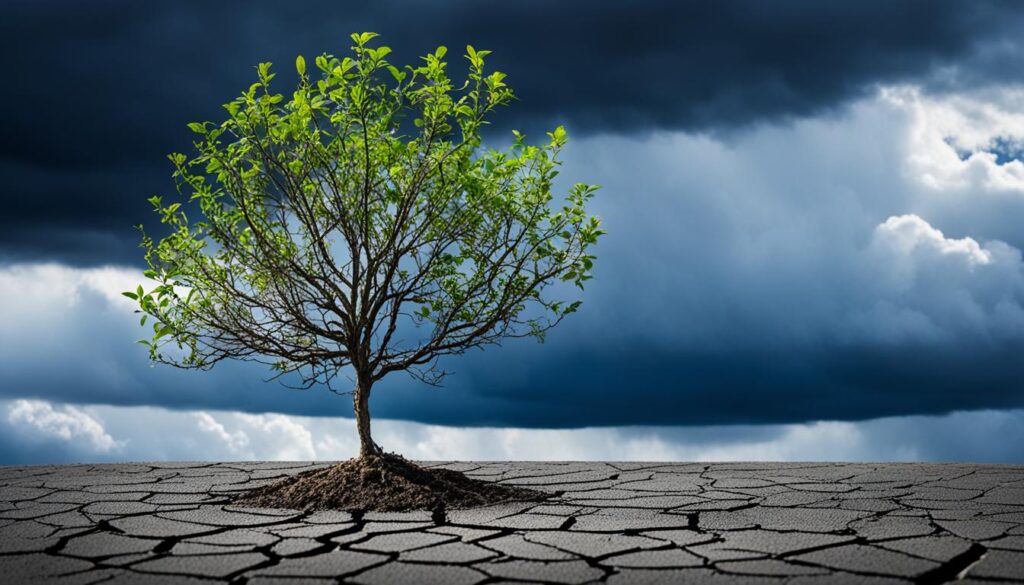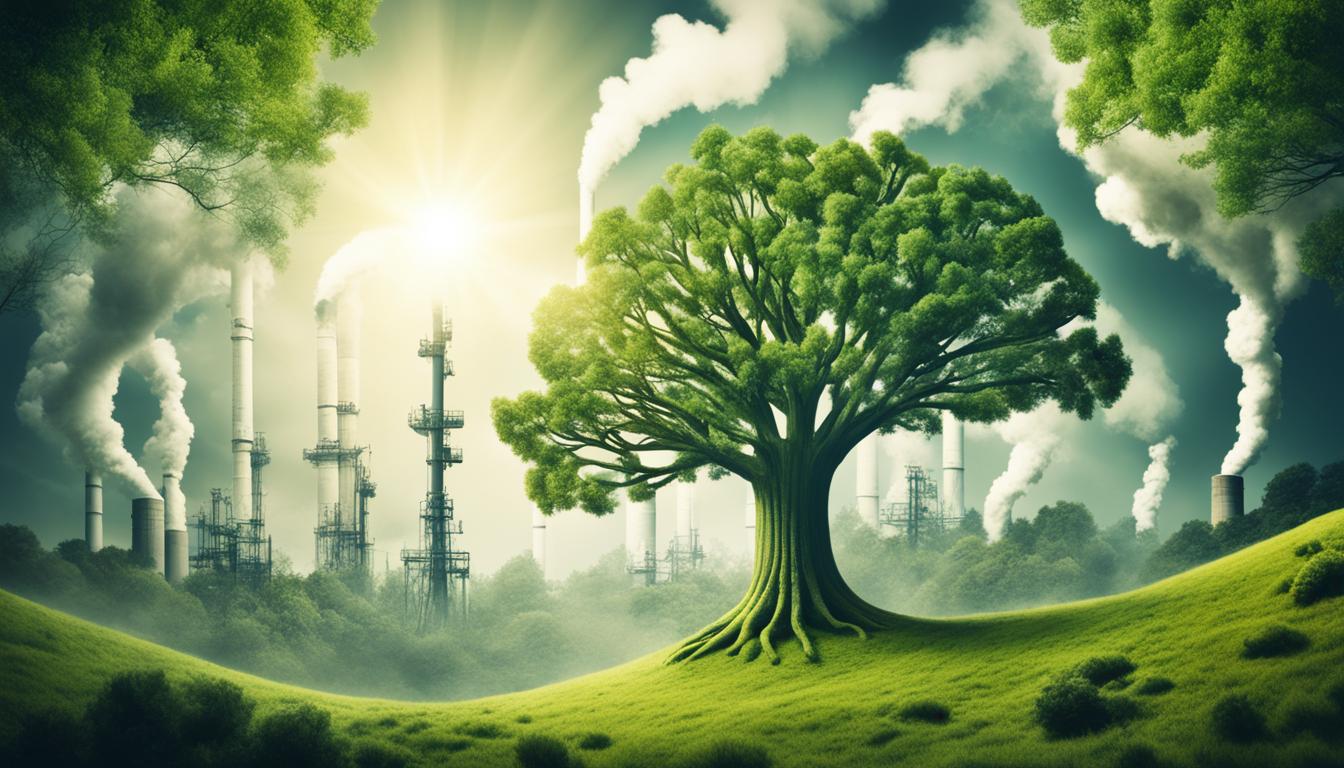Many people think a carbon footprint only means the CO2 that someone or something puts into the air. But it’s not just about CO2. A carbon footprint measures all greenhouse gases (GHGs) that come from a person, place, or thing. This includes CO2, methane (CH4), nitrous oxide (N2O), and F-gases, each with its own impact on the planet1.
Some think figuring out a carbon footprint is simple. Yet, it’s far from easy. It involves looking at many details like where you set the boundaries, what data you use, and the methods for working out the emissions1. Also, reducing our carbon footprint is a team effort. Everyone from individuals to companies to entire countries must do their part to fight climate change.
Key Takeaways
- Carbon footprint refers to the total amount of greenhouse gases, not just CO2 emissions.
- Calculating carbon footprint is a complex process that goes beyond simple CO2 measurements.
- Carbon footprint is a shared responsibility among individuals, businesses, and governments.
- Greenhouse gases, like methane and nitrous oxide, affect the planet differently.
- To cut carbon footprint, we need to tackle a wide range of emission sources.
Understanding Carbon Footprint: Beyond CO2 Emissions
Carbon footprint isn’t just about CO2. It also includes other gases that harm the environment. These are methane, nitrous oxide, and fluorinated gases. Each type has a different effect on the Earth’s climate. To make it easier to compare, we use CO2 equivalent. This shows us the impact of each gas in a way we can understand2.
Greenhouse Gases and CO2 Equivalents
Knowing about all the greenhouse gases is important. Methane and nitrous oxide are much stronger than CO2 at warming the Earth. Yet, we often focus only on CO2. For example, a flight from London to Edinburgh creates 136kg of CO2e. This tells us we need to think about the effects of different activities on our planet.
The food we eat is also a big part of our carbon footprint. A vegan diet has a much smaller carbon footprint than a meat-lover’s diet. Additionally, not all meats are the same. Beef makes much more CO2e per 1000 calories than pork. This info can help us choose what to eat to lower our impact on the planet2.
To fight climate change, we must look at all causes of a big carbon footprint. This approach helps us find the best ways to reduce our impact. It’s about understanding the many factors of our carbon footprint. Then, we can make choices that lead to a more sustainable future3.
“The concentration of greenhouse gases in the atmosphere reached 523 ppm CO2 equivalent in 2022, significantly surpassing the crucial 450 ppm CO2 equivalent level recommended for a 66% likelihood of complying with the 2-degree Celsius goal set in the Paris Agreement.”3
The Complexity of Carbon Footprint Calculations
Calculating a carbon footprint is complex. It depends on many factors. These include boundaries, scope, data sources, and assumptions4. For instance, the carbon footprint of a product changes. It changes if it includes emissions from raw materials, manufacturing, transportation, use, and disposal. It’s not a simple value4.
Measuring an individual’s carbon footprint also varies. It varies based on their lifestyle, what they consume, and their energy use4. So, a carbon footprint is more of an idea, not an exact number4.
Complex calculations call for detailed understanding. It shows how many things affect our carbon footprint4. We have more tools now to measure our impact. But we still need to think hard about the data we use5. Thanks to tools like CarbonTrail, Xero, and MYOB, even small businesses can do this easily. And quickly, in just 15 minutes5.
Plus, it’s not very expensive, about $50 a month. This way, companies can handle their carbon footprint better5.
But, there’s more to it than just counting our own emissions. Many businesses have a big carbon footprint that comes from what they don’t directly control. These are their scope 3 emissions. They make up around 70% of a company’s total carbon footprint6. Only checking their direct emissions (scope 1 and 2) misses a lot of the story. It misses over 80% of their emissions6.
The world is connected. Our actions touch many others. The UN’s Sustainable Development Goals know this well. They show that for change to work, we have to think about everything together4. Solving the problem of carbon footprints is key to making our world more sustainable and reducing climate change4.
| Metric | Value | Reference |
|---|---|---|
| Over 90% of businesses in New Zealand are SMEs | – | 5 |
| 32% of consumers are highly engaged in pursuing a more sustainable lifestyle | – | 5 |
| Carbon accounting process can be achieved in 15 minutes using tools like CarbonTrail, Xero, and MYOB | – | 5 |
| Cost of using a tool like CarbonTrail is approximately under $50 per month | – | 5 |
| Scope 3 emissions account for approximately 70% of many businesses’ carbon footprints | – | 6 |
| Measuring and reporting only scope 1 and 2 emissions leaves many businesses with over 80% of their emissions unrecorded | – | 6 |
| 68% chance of suppliers responding to emission data requests when asked by two companies | – | 6 |
| 76% chance of suppliers responding to emission data requests when asked by three companies | – | 6 |
| 25.9% increase in impact investing in the last 3 years, amounting to $636 billion | – | 6 |
| 78% of Americans prefer to buy environmentally friendly products | – | 6 |
| 20% of Americans don’t trust that reporting companies are eco-conscious | – | 6 |
“The complexity of carbon footprint calculations highlights the need for a nuanced understanding of the various factors that contribute to it.”
Calculating our carbon footprint isn’t simple. It’s all about understanding what affects our impact. This includes more than what we directly do4.
We now have tools to help us. But using them properly is still important. Tools like CarbonTrail, Xero, and MYOB make this easier, even for small businesses5. They can make the process fast and affordable, costing about $50 a month5.
But, our impact isn’t just about what we directly control. Many businesses miss a lot of their carbon emissions by not looking at everything. They miss over 80% of their emissions this way6.
The world is very connected. Our choices affect everyone. The UN’s Sustainable Development Goals remind us of this. They tell us that everything is linked. So, addressing our carbon footprints is key. It helps make our world sustainable and fights climate change4.
This is why we need to tackle the challenge of figuring out our carbon footprints. It shows us how to make real progress towards a better world.
Distinguishing Carbon Footprint from Ecological Footprint
The terms “carbon footprint” and “ecological footprint” might sound similar. But, they measure different parts of our impact on the planet7. The carbon footprint looks at how our activities, like burning fossil fuels, add to climate change. On the other hand, the ecological footprint shows us how much land and water we need for our lifestyle, including the waste we create.
It’s important to note that the ecological footprint is more than just consumption. It includes the planet’s ability to recover from our actions and clean up our waste8. This wider approach paints a clearer, more detailed picture of how sustainably we’re living8.
Measuring Environmental Impact
When we think about our impact on the environment, we need to look at many things, not just carbon9. This list includes water use, space we take up, loss of plant and animal life, dirty air, and the trash we make9.
The carbon and ecological footprints are just a first step. They don’t show the whole picture when used alone. They each tell us different parts of how green or harmful our actions are.
Many experts suggest using several measures, including the ecological footprint, to make better decisions8. These new approaches, like the UN’s System of Environmental and Economic Accounting, aim to give us a more detailed and joined-up view of our impact8.
By knowing the differences between carbon and ecological footprints, we can tackle environmental problems better. This knowledge helps us find more complete solutions to sustainability issues789.
carbon footprint misconceptions: A Shared Responsibility
Many think solving our carbon footprint is up to just one person. But, it’s really a team effort. It takes everyone working together, from regular people to big companies and even governments, to tackle climate change.
Individual, Business, and Government Roles
Our carbon footprint isn’t just what we directly produce. It’s also about the stuff that happens before and after what we do. Like, the impact of a product not only from making it but also from selling it and using it, to when it’s thrown away10.
People can help by making small changes in their daily lives. This might mean using less energy, switching to renewable sources, and following green practices. Companies have a big part too, by aiming for cleaner processes, putting money into green tech, and watching their whole supply chain11.
But, governments also have a key role. They can set rules that push everyone towards a cleaner future. This could be through carbon taxes, trading pollution rights, or investing in renewable energy sources11.
Together, we can fight climate change. By combining our efforts, we can have a bigger impact on reducing our carbon footprint and changing our planet for the better10.

“Tackling climate change is a collective effort that requires the collaboration of all stakeholders, from individuals to governments. Only by sharing the responsibility can we achieve meaningful and lasting change.”
Businesses are now taking on more complex approaches to lessen their impact. They are using tools like Life Cycle Assessment to choose greener options. While it’s a good start, our focus shouldn’t only be on reducing carbon. We must also consider other factors to ensure a truly sustainable future1210..
It’s crucial that we understand the joint effort needed. It’s not just up to you or me. It’s everyone working side by side. By doing so, we can lead the way to a world that’s better for all101112.
Holistic Approach to Sustainability: Beyond Carbon Footprint
Carbon footprint measures greenhouse gas emissions. But, it’s not the only thing important for the environment. We need to focus on environmental, social, and economic areas as well13. Actions to fight climate change have largely focused on reducing carbon. While this is crucial, true sustainability means looking at bigger challenges. This includes biodiversity loss, economic fairness, and saving resources13.
Taking a holistic view means looking at many aspects, not just carbon. We should also consider ecological footprint and circular economy models13. It’s vital to broaden how we see sustainability beyond carbon data. This includes protecting nature, using sustainable production technologies, creating green cities, and managing finances in an ecological way13.
Embracing regenerative sustainability means working to restore ecosystems. It includes promoting healthy ecological systems and using recycling systems13. This approach aims to address several problems. It balances the needs of society, economy, and environment over time13.
“Sustainability must address interconnected challenges and balance social, economic, and environmental imperatives for long-term prosperity.”
14 The success of carbon offsetting depends on the projects used. Carbon offsets are part of a wider plan for environmental health. They are not an excuse to keep polluting14. It’s advised that organizations reduce their emissions and support offsetting. This helps fund important ecological projects14.
15 Choosing renewable energy sources is becoming more crucial. Demand is rising for eco-friendly and ethical practices15. To be commendable, organizations must use renewable energy from trusted sources. They must look for certifications like the Gold Standard. This way, they contribute positively to society and the planet throughout the energy’s life cycle15.
In summary, a holistic view is key to tackle the world’s challenges. We must go beyond only caring about carbon. By considering the environment, society, and economy together, we pave the way for a better future.
Renewable Energy: Affordable and Reliable
Solar and wind power are now some of the cheapest ways to make electricity. These renewable sources can be up to nine times more affordable than fossil fuels16. The cost of using renewable energy has dropped quickly. This has made it a budget-friendly and dependable choice for fighting climate change16.
New technologies in storing power help overcome the idea that renewables only work in ideal conditions. They are making it possible to use renewable energy all the time16.
Dispelling Cost and Availability Myths
Today, generating energy from the wind and sun costs roughly $44/MWh and $50/MWh globally16. In the U.S., wind and solar power are cheaper than most natural gas options. They cost between $24-46/MWh and $31-111/MWh16.
Also, the price of storing energy in batteries has dropped from about $600/MWh in 2015 to roughly $150/MWh by 202016. This makes storing renewable energy more affordable and practical16.
Investing in renewable energy is key to a cleaner future. Wind and solar power now offer the least expensive electricity for 67% of the globe16.
| Renewable Energy | Cost ($/MWh) |
|---|---|
| Onshore Wind | $24-46 |
| Utility-Scale Solar | $31-111 |
| Battery Storage | $150 |
Renewable energy is now both cheap and reliable. Its lower costs and new tech have made it a leading solution against climate change. It’s time to embrace renewables for a sustainable future16.
Adapting to Climate Change: Challenges and Opportunities
Climate change is now in our backyard, impacting global food supplies, migration, and more. We must quickly adapt. This change affects cities, companies, and countries everywhere.
Dealing with climate change means solving big, interconnected problems. Extreme weather, shifting environments, and shaky systems need our attention. But moving to a sustainable, low-carbon way of life offers new chances.
One challenge is how climate change differs across industries. Farms, for example, make lots of emissions but feed many people. So, they must find new, eco-friendly ways to operate.
Meanwhile, feeding the growing world must be balanced with cutting waste and emissions. Regenerating the land and using resources wisely can help. This way, we fight climate change and make sure there’s enough food for everyone.
Developing clean energy and eco-friendly technology means new jobs and less pollution. Fully electric cars, for instance, are much greener than those using gas.
Working together, we can tackle climate change. By addressing the challenges and seizing the opportunities, we can create a brighter, more sustainable world.

“The United Nations has warned that without immediate climate action, millions of people across the globe will face increased poverty, conflict, and instability.”17
It’s time for us to find ways to adapt to climate change that offer a balance. They need to tackle challenges while using opportunities to make a better, more sustainable future for everyone.
Polar Bears and Arctic Wildlife: Vulnerable to Climate Change
Climate change is hitting the Arctic the hardest. The Arctic is warming four times quicker than the global average18. This fast change is causing Arctic sea ice to vanish sooner and return later each year. It’s a big danger for animals like the polar bear18.
As the sea ice shrinks, polar bears find it hard to hunt for seals, their main food19. This means female polar bears struggle to find places to give birth and raise their young19. Because of this, experts believe polar bear numbers could drop by 30% by 205019.
The threat to polar bears and other Arctic wildlife shows why we need to tackle climate change and protect their homes18. In 2008, polar bears became the first on the U.S. endangered list, mainly because of melting sea ice18.
A Sabin Center report in 2021 found that almost all 1,497 endangered U.S. species face climate threats18. Plus, nearly a million species worldwide are in danger because of climate change. In 2019, a report said 40% of amphibians and many corals and mammals could become extinct18.
A 2022 study warned that sea life is heading towards the biggest die-off in 250 million years18. And in 2021, the United Nations said global warming and biodiversity loss are major threats to most living things18.
The International Polar Bear Conservation Agreement from 1973 has helped polar bears. It has limited or stopped hunting in many cases, aiding in their recovery19. Even so, polar bears are endangered and at-risk under U.S. law19.
“Addressing the threat of climate change is critical to the survival of polar bears and other Arctic wildlife. We must take immediate action to reduce greenhouse gas emissions and protect these fragile ecosystems.”
The polar bear‘s situation is serious, showing the need for quick climate change action182019.
Conclusion
The idea of a carbon footprint is more than just CO2 emissions. It includes the overall impact of all greenhouse gases on our climate21. Since the late 19th century, our world’s average temperature has gone up by 1.1 degrees Celsius. A big part of this change happened in the last 40 years21. Figuring out your real carbon footprint is not easy. It covers many areas, like how we measure it and where we get our info from22. 10% of climate discussions mentioned how hard it is to put a carbon label on products.
But, looking at just our carbon footprint is not enough to protect our planet. We need to take a bigger approach that looks at all parts of being eco-friendly. This includes caring about environmental, social, and economic issues22. At least 6% of talks pointed out that how far our food travels and buying local make a big difference22. And 2% says choosing organic products is key too23. Over the last decade, our global CO2 emissions hit a record high of 50 billion tons. Goals to store carbon away have not succeeded as we hoped.
Yet, we do have ways to fight climate change and lower our impact21. Scientists all over agree that global warming is our fault. But, we still have a little time to act this decade. If we work hard now, we can stop at 1.5 degrees Celsius global warming23. We’ve seen big progress in making eco-friendly tech cheaper. This includes solar panels, wind turbines, and electric cars.
FAQ
What is the difference between carbon footprint and greenhouse gas emissions?
How is carbon footprint calculated?
What is the difference between carbon footprint and ecological footprint?
Whose responsibility is it to reduce carbon footprint?
Is carbon footprint the only factor to consider for environmental sustainability?
Are renewable energy sources really more affordable and reliable than fossil fuels?
What are the challenges and opportunities in adapting to climate change?
How is climate change affecting the Arctic and its wildlife?
Source Links
- https://www.ecosystemmarketplace.com/articles/debunked-eight-myths-carbon-offsetting/ – Debunked: Eight Myths About Carbon Offsetting – Ecosystem Marketplace
- https://earthly.org/what-is-a-carbon-footprint – What Is A Carbon Footprint | About Carbon Emissions | Earthly Blog
- https://www.footprintnetwork.org/our-work/climate-change/ – Climate Change & the Carbon Footprint – Global Footprint Network
- https://www.tejaonthehorizon.com/sustainable-journey/climate-action/should-i-offset-my-carbon-footprint-misconceptions-faqs/ – Should I Offset My Carbon Footprint? Misconceptions & FAQs
- https://www.carbontrail.co/blog/five-myths-about-carbon-accounting – Five Common Carbon Accounting Myths… Busted!
- https://net0.com/blog/scope-3-myths – Scope 3 Emissions: 10 Myths Debunked – Net0
- https://www.c2es.org/wp-content/uploads/2017/03/misconceptions-realities-climate-science-06-2012.pdf – Microsoft Word – Misconceptions v Realities_C2ES Jun 2012[3].docx
- https://www.mdpi.com/2071-1050/2/6/1645 – A Review of the Ecological Footprint Indicator—Perceptions and Methods
- https://www.footprintnetwork.org/content/uploads/2020/08/Footprint-Limitations-and-Criticism.pdf – PDF
- https://www.linkedin.com/advice/3/what-most-common-carbon-footprint-myths-misconceptions – What are the most common carbon footprint myths and misconceptions?
- https://www.climateimpact.com/news-insights/insights/busting-carbon-offsetting-myths/ – Busting Carbon Offsetting Myths
- https://today.green/posts/debunking-3-misconceptions-about-a-corporate-carbon-footprint – Debunking 3 Misconceptions About a Corporate Carbon Footprint
- https://fundtheplanet.net/sustainability/carbon-tunnel-vision-crafting-a-more-holistic-plan-for-sustainability/ – Carbon Tunnel Vision: Crafting a More Holistic Plan for Sustainability. – Fund the Planet
- https://www.theethicalfuturists.com/the-essentials-of-carbon-offsetting-balancing-your-carbon-footprint/ – The Essentials of Carbon Offsetting: Balancing Your Carbon Footprint
- https://perspectives.se.com/blog-stream/beyond-carbon-emissions-why-responsible-renewables-matter – Beyond Carbon Emissions: Why Responsible Renewables Matter
- https://www.wri.org/insights/setting-record-straight-about-renewable-energy – Setting the Record Straight About Renewable Energy
- https://www.linkedin.com/pulse/debunking-misconceptions-climate-science-ehfaaz-wbqic?trk=public_post_main-feed-card_feed-article-content – Debunking Misconceptions About Climate Science
- https://insideclimatenews.org/news/03092023/research-link-between-emissions-polar-bear-decline/ – New Research Shows Direct Link Between Greenhouse Gas Emissions and Polar Bear Decline – Inside Climate News
- https://skepticalscience.com/polar-bears-global-warming.htm – How will global warming affect polar bears?
- https://polarbearsinternational.org/news-media/articles/sharing-climate-hope-over-the-holidays/ – Sharing Climate Hope Over the Holidays | Polar Bears International
- https://www.nationalgrid.com/stories/journey-to-net-zero-stories/6-myths-about-climate-change-busted – 6 myths about climate change busted
- https://carboncloud.com/climate-impact-misconceptions/ – Climate impact of food: Misconceptions (ebook) – CarbonCloud
- https://penntoday.upenn.edu/news/carbon-capture-and-common-misconceptions-qa-joe-romm – Carbon capture and common misconceptions: A Q&A with Joe Romm | Penn Today

